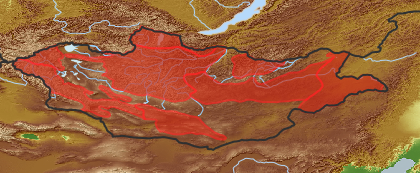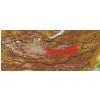| Class: | angiosperms |
| Order: | Saxifragales |
| Family: | Saxifragaceae |
| Genus: | Saxifraga |
| Scientific name: | Saxifraga cernua L. |
| Name acc. to: | Gubanov 1996 |
| Herbar: | list records    |
| Link to Flora of China: | http://www.efloras.org/browse.aspx?flora_id=2&name_str=Saxifraga+cernua |
| open map in a new window |  |
| Habitat: | Kobresia communities, stone and rock debris fields, brook banks and pebbles, rocks and cliffs in alpine belt and in upper part of forest belt (Grubov 2001). |
| Habit (i)general appearance of a plant | |
| Growth form: (i)Herb, shrub, tree or climber. | herb (i)Herbaceous, erect plant, up to 2m high, mostly with a leafy shoot; if perennial, shoots die to the ground each season, shoots are not woody
example: Artemisia pectinata   inherited by family Saxifragaceae: herb inherited by family Saxifragaceae: herb  inherited by genus Saxifraga: herb inherited by genus Saxifraga: herb
perennial (i)Living for several to many years, as opposed to annual and biennial  inherited by genus Saxifraga: perennial inherited by genus Saxifraga: perennial
|
| Parasite status: (i)Is the plant a half- or full parasite? | no parasite/saprophyte (i)Plant fully autonomous, leaves with chlorophyll
example: Most plants, Ranunculus  inherited by family Saxifragaceae: no parasite/saprophyte inherited by family Saxifragaceae: no parasite/saprophyte
|
| Water or terrestrial plant: (i)Where do the plants grow? | terrestrial (i)Plant grows on dry land
example: Orostachys spinosa  inherited by genus Saxifraga: terrestrial inherited by genus Saxifraga: terrestrial
|
| Leaf (i)expanded, usually photosynthetic organ of a plant (including phylloclades) | |
| Leaf development: (i)Structure and development of leaves. | with green leaves (i)Plant with green leaves  inherited by genus Saxifraga: with green leaves inherited by genus Saxifraga: with green leaves
|
| Simple or divided leaves: (i)Are the leaves simple or completely divided in several parts? Blade of the leaf entire or (more or less) deeply dissected. Attention: There are various appearances of the leaf margin (from entire to toothed and lobed). Here, we ignore this and ask only for dissections that separate the leaf for more than one third of its length or width, whatever is smaller. Sometimes, it is difficult to tell apart compound leaves from a shoot system with simple leaves: look for stipulae and/or axillary buds at the ground of the leaves: if only some possess these structures, the others are most likely leaflets of a compound leaf. | simple (i)Non-divided leaf, but margin may be incised nearly to the ground   inherited by genus Saxifraga: simple inherited by genus Saxifraga: simple
|
| Leaf margin: (i)Structure of leaf margin (or that of a leaflet in case of compound leaves). Attention: Here we ask for the leaf margin, defined as all those dissections that separate the leaf for less than one third of its length or width, whatever is smaller. To be worked out: how to handle margin of pinnate leaves? | serrate / dentate / crenulate (i)Margin saw-like or rounded teethed
example: Betula, Lophanthus (crenulate)   inherited by genus Saxifraga: serrate / dentate / crenulate inherited by genus Saxifraga: serrate / dentate / crenulate
|
| Leaf veination: (i)Arrangement of the main veins of a leaf. | pinnate (i)One main vein, several side veins, sometimes inconspicuous
example: Cicerbita     inherited by family Saxifragaceae: pinnate inherited by family Saxifragaceae: pinnate
|
| Flower (i)reproductive portion of the plant, consisting of sepals, petals, stamens, and pistils | |
| Flower appearance and pollination: (i)General appearance of the flower. | attractive, animal-pollinated (i)attractive and coloured flowers, mostly large, attracting surely animals
example: Trollius, Rosa, Chamaerhodos  inherited by genus Saxifraga: attractive, animal-pollinated inherited by genus Saxifraga: attractive, animal-pollinated
|
| Perianth arrangement: (i)Attention: in some plants, flowers may be dimorphic in different ways (dioecious or gynodioecious). If flowers vary, record the characters of the most showy flowers. | double, different (i)Two types of perianth leaves, differently coloured (sepals: outer periant leaves, usually greenish, and petals: inner perianth leaves, usually coloured)
example: Parnassia    inherited by genus Saxifraga: double, different inherited by genus Saxifraga: double, different
|
| Flower symmetry: (i)Symmetry of the perianth leaves. Attention: to assess this character, look on sepals, petals and stamens, but neglect carpels and ovary. | radiary, regular (actinomorphic) (i)More than two axis of symmetry
example: Saxifraga: 5; Iris: 3   inherited by genus Saxifraga: radiary, regular (actinomorphic) inherited by genus Saxifraga: radiary, regular (actinomorphic)
|
| Flower form: (i)common forms of flowers ? Veronica | simple (flat) - Do not confuse with inflorescences as in some Asteraceae (i)Petals spread out, flower appearing flat
example: Mollugo, Trientalis, Pulsatilla, Saxifraga   inherited by family Saxifragaceae: simple (flat) - Do not confuse with inflorescences as in some Asteraceae inherited by family Saxifragaceae: simple (flat) - Do not confuse with inflorescences as in some Asteraceae
Hypanthium developed (i)Cup-shaped extension of the floral axis developed (receptacle accrescent)
example: Saxifragaceae, Rosaceae p.p., Lythraceae  inherited by family Saxifragaceae: Hypanthium developed inherited by family Saxifragaceae: Hypanthium developed
|
| Sepal number: (i)Number of sepal leaves (outer perianth leaves, calyx leaves, mostly greenish). Attention, this character applies only for flowers separated in sepals and petals, thus excluding most monocots. Be aware of the bracts (involucral leaves) of Asteraceae flowerheads, do not qualify these as sepals! Be also aware in Rosaceae is often an epicalyx developed, in this case count all parts. | 5 (i)
example: Polemonium  inherited by genus Saxifraga: 5 inherited by genus Saxifraga: 5
|
| Sepal fusion: (i)To which degree are the sepal leaves connected? Attention, this character applies only for flowers separated in sepals and petals, thus excluding most monocots. Be aware of the bracts (involucral leaves) of Asteraceae flowerheads, do not qualify these as sepals! | free (i)All leaves separate from each other
example: Geranium  inherited by family Saxifragaceae: free inherited by family Saxifragaceae: free  inherited by genus Saxifraga: free inherited by genus Saxifraga: free
|
| Petal / Tepal number: (i)Number of petal leaves (inner perianth leaves, usually coloured). | 5 (i)
example: Potentilla  inherited by genus Saxifraga: 5 inherited by genus Saxifraga: 5
|
| Petal / Tepal fusion: (i)To which degree are the petal leaves connected? Petals sympetalous. | free (i)all petal leaves separate from each other
example: Anthriscus  inherited by family Saxifragaceae: free inherited by family Saxifragaceae: free  inherited by genus Saxifraga: free inherited by genus Saxifraga: free
|
| Spur: (i)A hollow, slender, sac-like appendage of the perianth leaves, storing nectar. | no spur (i)Flower without appendage
example: Peganum  inherited by family Saxifragaceae: no spur inherited by family Saxifragaceae: no spur
|
| Stamen number: (i)Attention: We ask for the reproductive organs of the flower dispersing pollen. Count only fully fertile stamens, not staminodia (e.g. Parnassia). | 10 (i)
example: Silene  inherited by genus Saxifraga: 10 inherited by genus Saxifraga: 10
|
| Stamen fusion: (i)To which degree are the stamens fused? Attention: Whereas the pollen sacs itself are often free., their stalks (filaments) may be fused. Here, we count them as fused if they are together over at least one thirth of their length. | free (i)Stamens with separate bases
example: Malus  inherited by genus Saxifraga: free inherited by genus Saxifraga: free
|
| Style number: (i)Portion of the pistil connecting the stigma to the ovary. | 2  inherited by genus Saxifraga: 2 inherited by genus Saxifraga: 2
|
| Sex: (i)Distribution of male and female organs among flowers, only most commonly cases. | bisexual, hermaphrodite (i)All or nearly all flowers of a plant with male and female parts
example: Haplophyllum, Chenopodium  inherited by genus Saxifraga: bisexual, hermaphrodite inherited by genus Saxifraga: bisexual, hermaphrodite
|
| Fruit (i)the seed bearing organ, with or without adnate parts; a ripened ovary and any other structures which are attached and ripen with it. Aggregate fruits are handled like simple fruits for determination. | |
| Consistency: (i)Fleshy fruits or dry fruits, see dispersal adaptations for further classification. | dry (i)With a dry outer shell, no fleshy parts, but seed (embryo) could be edible  inherited by genus Saxifraga: dry inherited by genus Saxifraga: dry
|
| Type of fruit: (i)Common fruit types (including pseudocarp). | Solitary fruits (i)     inherited by genus Saxifraga: Solitary fruits inherited by genus Saxifraga: Solitary fruits
capsule (i)Dry dehiscent fruit, releasing seeds by slits or holes.
example: Poppy, most Caryophyllaceae, Cerastium, a lot of Scrophulariaceae, Iris (oppened capsule looks like Delphinium), Zygophyllum - it is a very common fruit type     inherited by genus Saxifraga: capsule inherited by genus Saxifraga: capsule
Dehiscent fruits (i)Fruits open along a longitudinale line (except silicula)  inherited by genus Saxifraga: Dehiscent fruits inherited by genus Saxifraga: Dehiscent fruits
|
| Root / shoot below ground (i)plant part below ground (in most cases), including below ground shoots, without leaves | |
| Root type: (i)Organisation of the roots. | allorhizous (i)Plant with a conspicuous tap root, one larger tap root with side roots
example: Dicotyledonae  inherited by order Saxifragales: allorhizous inherited by order Saxifragales: allorhizous
|
| Runners: (i)Plant must be excavated; shoots, subterranean shoots connected by runners. | stolons (i)Plants creep with above-ground shoots (stolons) which can root and establish new plants
example: Potentilla arenaria, P. anserina   inherited by genus Saxifraga: stolons inherited by genus Saxifraga: stolons
|
| Distribution (i)region where the plant is likely to be found | |
| Distribution (Veg. Zones): (i)acc. to Grubov 1952 | Khubsgul (i)In distribution data often named as '1' 
Khentei (i)In distribution data often named as '2' 
Khangai (i)In distribution data often named as '3' 
Khobdo (i)In distribution data often named as '6' 
Mongolian Altai (i)In distribution data often named as '7' 
Middle Khalkha (i)In distribution data often named as '8' 
East Mongolia (i)In distribution data often named as '9' 
Gobi-Altai (i)In distribution data often named as '13' 
acc. to: Gubanov 1996 |
| Distribution Khangay: (i)acc. Flora Khangaya 1989 | I
II
III
IV
V
VI
|